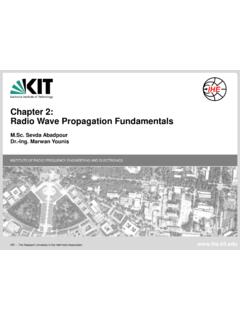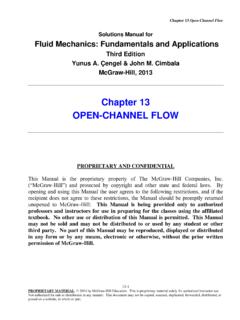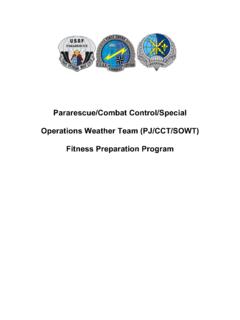Transcription of Section 15 – Freefall with Air Resistance - CSU, Chico
1 Physics 204A Class Notes 15-1 Section 15 Freefall with Air Resistance Outline 1. The Force of Air Resistance 2. The Equations of Motion Objects do what they do because of the forces acting on them. Up until now, we have only looked at constant forces that cause constant accelerations. In this Section , we ll see that Newton s Laws also work for non-constant forces. In the process, we ll be able to begin to understand motion with air Resistance included. 1. The Force of Air Resistance The Rule of Falling Bodies only works when air Resistance is ignored. The reason we ignored it before was because it is complicated, but with our understanding of Newton s Laws of Motion we can attack it. Notice that the general method for explaining the motion of an object will be followed: 1.
2 Find the forces acting on the object. 2. Use Newton s Laws of Motion to find the acceleration. 3. Use the definition of acceleration and the initial position and velocity to find the motion. The force of air Resistance through a fluid at low speeds is known to be proportional to the speed of the moving object, Fd=bv. That is, the faster it moves the stronger the air Resistance . You might know this because you have held your hand outside the window of a car as the car sped up. The quantity b depends on the size and shape of an object as well as the properties of the fluid through which it is moving. We won t go into those details here we ll just leave it as b and call it the coefficient of air Resistance . The Force of Air Resistance Fd=bv Applying the Second Law to a falling object using the coordinates at the right, Fy=may Fg Fd=ma mg bv=ma, where the mass/weight rule has been used.
3 Since the force of air Resistance increases as the speed of the falling object increases, eventually, the forces are equal and the object falls at a constant speed called the terminal speed. The terminal speed is, a=0 mg bvt=0 bvt=mg vt=mgb. The Definition of the Terminal Speed vt mgb y x g F F d Physics 204A Class Notes 15-2 Example : A raindrop has a mass of and falls a distance of 2000m nearly all of which is at a terminal speed of Find (a)the speed at which the raindrop would strike the ground if there were no air Resistance , (b)the time it would take to reach the ground with no air Resistance , (c)the force of air Resistance when the raindrop is traveling at terminal speed and (d)the coefficient of air Resistance for this raindrop.
4 Given: m = , vt = Find: v = ?, t = ?, Fd = ?, and b = ? Note that we are using coordinates with downward as positive. (a)If there were no air Resistance , the acceleration is a constant, g, and we can use the kinematic equation without the time, v2=vo2+2a(y yo) v=2ax=2( )(2000) v=198m/s=443mph! Thank goodness for air Resistance ! (b)Use the definition of acceleration, a v t t=va= t= falls two kilometers in only twenty seconds. (c)At terminal speed, the acceleration is zero so the Second Law says the net force is zero. The force of air Resistance must equal the weight, Fy=may Fg Fd=0 Fd=Fg=mg=( )( ) Fd= (d)The force of air Resistance is, Fd=bv. At terminal speed, Fd=bvt b=Fdvt= b= 3kgs. 2. The Equations of Motion What about other questions like How long does it take to reach terminal speed?
5 Or How long does the drop actually take to fall? The answers to these questions can be found by applying the Second Law to get the acceleration. Substituting the definition of terminal speed into the equation from the Second Law, Fy=may Fg Fd=ma mg bv=ma bvt bv=ma a=bmvt v(). Using the definition of acceleration, dvdt=bmvt v(). This is a differential equation for the velocity. Rearranging the terms so that it can be integrated, dvvt v=bmdt dvvt v0v =bmdt0t . y x g F F d yo = 0 y = 2000m vo = 0 v = ? a = t = ? y x g F F d Physics 204A Class Notes 15-3 Notice that we have used limits that assume the initial conditions are that the raindrop is at rest when t = 0. The integral on the right is straightforward. The integral on the left can be done by a substitution.
6 The results are, ln1 vvt =bmt. Solving for the velocity as a function of time, v=vt1 e bmt . Note that at t=0, v=0 and that as t , v vt as we have been saying. Also, notice that the velocity depends upon the mass of the object, just as we know it does from everyday experience. Example : A raindrop has a mass of and falls a distance of 2000m nearly all of which is at a terminal speed of Find the time it takes to (a)reach terminal speed and (b)reach the ground. Given: m = , vt = , and y = 2000m Find: t = ? and tg = ? (a)Looking at the equation we just derived, v=vt1 e bmt , it will take an infinite amount of time to reach terminal speed, so we need to modify the question. How long will it take to reach 99% of terminal speed? e bmt e bmt e bmt= Solving for t by taking the log, bmt=ln( ) bmt=ln(100) t=mbln(100)= (100) t = (b)Since the raindrop reaches terminal speed in only 4s, it is essentially moving at terminal speed for the entire fall.
7 So, we can assume constant speed use the definition of average velocity, v x t=ytg tg=yvt= t = 235s. Let s get the equation for the position as a function of time. Using the expression above for the velocity and combining it with the definition of velocity, dxdt=vt1 e bmt dxxox(t) =vt1 e bmt dt0t . Doing the integrations, x xo=vtdt0t vte bmtdt0t =vtt+vtmbe bmt|0t=vtt+vtmbe bmt 1 . y x g F F d Physics 204A Class Notes 15-4 Finally, x=xo+vtt+vtmbe bmt 1 . That s a pretty complicated result. However, the point here is no matter how complex the force, it does explain the motion. The general steps are: 1. Find the forces acting on the object. 2. Use Newton s Laws of Motion to find the acceleration. 3. Use the definition of acceleration and the initial position and velocity to find the motion.
8 Why haven t we gone through this process before? Until now, the forces we have been looking at were all constant. Therefore, the accelerations were constant. So, we already knew the answer, it was the kinematic equations. Here, the force was not constant, so the equations of motion are not the kinematic equations. Section Summary We followed our recipe to understand the motion of a free falling object with air Resistance . 1. Find the forces acting on the object. 2. Use Newton s Laws of Motion to find the acceleration of the object. 3. Use the definition of acceleration and the initial position and velocity to find the motion. We assumed the force of air Resistance was proportional to the velocity, The Force of Air Resistance Fd=bv, where b is the coefficient of air Resistance which depends upon the size and shape of an object as well as the properties of the fluid through which it is moving.
9 As objects speed up, the force increases eventually equaling the gravitational force. At which point, the speed becomes constant and we defined the terminal speed The Definition of the Terminal Speed vt mgb. Next, used the Second Law and the definitions of acceleration and velocity to get equations of motion for an object falling with air Resistance , a(v)=bmvt v() v(t)=vt1 e bmt x(t)=xo+vtt+vtmbe bmt 1 . Physics 204A Class Notes 15-5 A Summary of the Course to Date Why do objects do what they do? An answer to that question is because of the forces that act on them. The concept of force is summarized by Newton s Laws of Motion.









![D 11] 03 -F y Ey5 2Ta Tog-2 24 31 52 +33.33-1 62 1-2rs ...](/cache/preview/1/8/2/7/6/9/f/c/thumb-182769fc654e76aeda83ea6dbb83f2ce.jpg)
